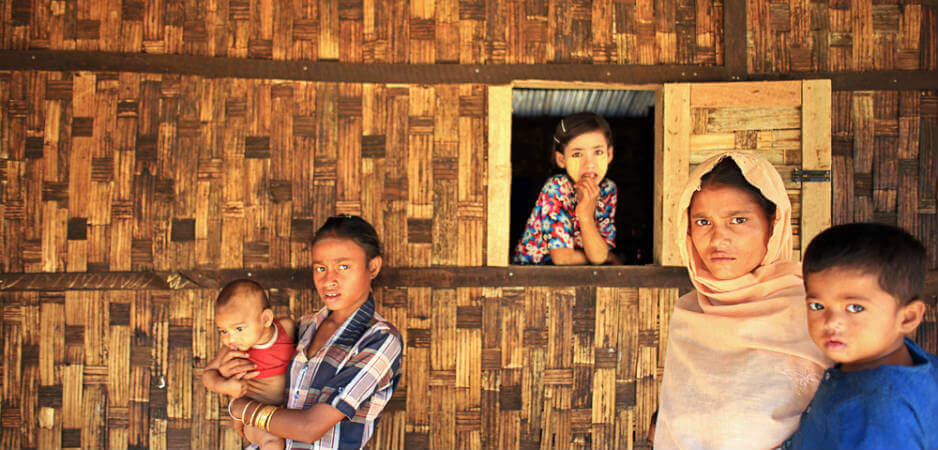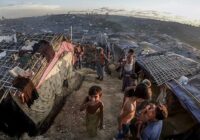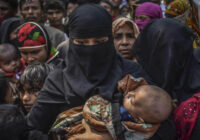The fate of the Rohingya reflects the plights of ethnic minorities throughout history and across the world.
The Rohingya are a persecuted Muslim minority living mainly in western Myanmar. Their origins are a subject of immense dispute and controversy. Some views hold that they are the progeny of Muslims who settled in Myanmar several centuries ago, while others point out a 19th-century origin when what was then known as Burma was ruled from India by the British. Additionally, on the latter view, the British incited them to Islamic fanaticism and instigated to attack Buddhist communities and temples. Confusion also exists over their actual numbers. Figures of 7 million, 3.5 million and 1.5 million have been mentioned; most studies talk about 1 million.
The confusion about who the Rohingya are is further compounded by conflicting views about their religion and ethnic origin. According to one view, there are also Hindus among them, while others allege that they are Biharis who fought on the side of Pakistan in 1971 and, when Bangladesh came into being, fled to Burma. The more reliable evidence suggests that they are Bengali Muslims whose ancestors migrated from Chittagong at some point in time, mostly in the 19th century, when the British ruled not only the Indian subcontinent, but also Burma.
What is true without doubt is that the Rohingya are a highly impoverished community whom the military wants to purge from Myanmar. Nobel Prize winner Aung San Suu Kyi, who famously led the struggle against military rule and is now the elected state counselor of Myanmar, has not done much to protect them. Both the military and her government claim that reports of Rohingya persecution are fabricated, but human rights organizations are talking of massive persecution. On the other hand, they accuse the Rohingya of terrorism. They identify the Arakan Rohingya Salvation Army as a terrorist organization trying to destabilize Myanmar and create a separate state for itself in the west.
Now, the truth is that Myanmar has generally treated several of its minorities badly, but the Rohingya are not even recognized as such in state with an 87% Buddhist majority of the total population of around 50 million.
The 1 million Rohingya live in Rakhine State, the westernmost region of Myanmar. They have been excluded from citizenship and are considered outsiders. Since the 1970s, attacks on them became more frequent and better organized, ordered by the army. On several occasions, they fled to Bangladesh when violence against them increased. The government placed them in refugee camps, strictly isolated from Bangladeshi society. Still, some managed to leave the camps and joined mainstream society, but for most, life in the camp was a forced isolation in appalling conditions. On a number of occasions, the Rohingya agreed to return to their homes in Rakhine after agreement between the Myanmar and Bangladesh governments. However, attacks on them continued. Since 2011, the Rohingya have faced recurrent state-sponsored terrorism.
Small communities of Rohingya have sought refuge in Thailand, Malaysia and Indonesia as well. Some ventured to come to Pakistan and Afghanistan where some joined the mujahedeen. Radicalized Rohingya have been responsible for terrorist attacks on the Burmese, including police stations and the army. As always, such terrorism has been met with overwhelming force of the state and crushed but, as a result, the persecution of the Rohingya has only intensified and forced them to flee. Giving the geographical proximity, most of them have headed to Bangladesh, where the government is determined not to let them settle down on a permanent basis.
Larger Tragedy
The tragedy of the Rohingya needs to be understood in the context of the larger tragedy of minorities all over the world. When the former colonial powers — the British, French and Dutch — withdrew from their colonies in Asia and Africa, they left behind states that did not correspond to religious or ethnic homogeneity. The presumption was that the states would adopt inclusive policies and ethnic majorities and minorities would live in peace as equal citizens. The reality turned out to be very different.
For example, Pakistan was created for Indian Muslims because the Muslim League claimed that Muslims were a separate nation. However, when India was partitioned and Pakistan came into being, it was constituted by two separate geographical units — East and West Pakistan — where Muslims were a majority. Political and economic power in Pakistan rested in West Pakistan. It was dominated by the Punjabi military and the Punjabi Urdu-speaking civil service. The majority group of Bengali Muslims of East Pakistan felt neglected, dominated and exploited by the power elite from West Pakistan.
Much worse, the 10% of Hindus and Sikhs who were supposed to become Pakistani citizens migrated to India because they were attacked by organized groups of armed men. The state did not act decisively to prevent the violence against them. As a result, only a tiny minority of Hindus survived in West Pakistan. They are confined to the interior Sindh province and make up only 1.5% of the total Pakistani population. Only West Pakistan is part of the present-day Pakistan, as East Pakistan broke away in 1971 after a bloody war with West Pakistan and became Bangladesh.
In the former Punjab province, which was partitioned between India and Pakistan, there was complete ethnic and religious cleansing. The 6 million Muslims who belonged to areas that became the Indian East Punjab had to run for their lives to cross the border and find safe haven in Pakistan. Only a tiny minority of Muslims stayed behind in the princely state of Malerkotla. From what became the Pakistani West Punjab, 4.5 million Hindus and Sikhs had to flee to the last man.
Now, on the other side of the subcontinent, in the former East Pakistan, more than a fifth of the population was going to be made up of Hindus. In 1947, communal violence in Bengal was far less than in Punjab, although Bengal too was partitioned between a Muslim-majority East Bengal and a Hindu-majority West Bengal. Consequently, minorities remained behind in large numbers on both sides. This was achieved largely by the presence of Mahatma Gandhi, who stayed in Calcutta to ensure that the Muslims were protected.
However, from 1948 onward, Hindus began to be recurrently attacked by Muslims. Such attacks could not have happened with the connivance of the politicians. In any case, waves of Hindu Bengalis began to migrate to India. At the time of the civil war in East Pakistan, nearly a fifth of the population was Hindu. When the war ended and Bangladesh emerged as an independent state, the Hindu percentage of the population had gone down to 12%. It is now 10%.
On the other hand, in sharp contrast to what happened in Pakistan, with the exception of East Punjab, in the rest of India, where the Congress party formed the government, the 10% Muslim minority survived because of the leadership of Mahatma Gandhi and Jawaharlal Nehru. Indian Muslims now make up over 14% of the total Indian population. Their proportion of the population has increased.
The ultimate irony has been that the Biharis who had settled in East Pakistan fought on the side of the Pakistan army in the civil war in 1971. After Bangladesh came into being they felt insecure in the country, but Pakistan refused to accept them. They are stranded Pakistanis in Bangladesh but, in Pakistan, there is no home for them either.
Mercy and Apathy
In this regard, the example of Israel is worth mentioning. Israel was created for the Jews. It has subsequently taken full responsibility by accepting Jews from all over the world to come and settle in the country. Of course, such policy of the so-called Law of Return applies only to Jews — not to the Palestinians who lived there before Israel came into being. Hundreds of thousands of Palestinians had to run for their lives in 1948, and again in 1967 and after, following the wars between Israel and Arab states. They are denied a return to their homes.
The tragedy of the Rohingya and of minorities elsewhere is the ethnicization of the nation state project. Such ethnicization can derive from ethnic, religious or even sectarian factors. In India, ultra-nationalist Hindus want to establish the Hindu Rashtra or the Hindu nation state. Attacks on Muslims, Sikhs and even Christians have occurred in India, sometimes claiming thousands of lives. Pakistan is an Islamic state in which sectarian terrorism is endemic. The Sunnis constitute the clear majority. The Shia have been targeted in frequent attacks. So have Christians, Hindus and the tiny Ahmadiyya community who are categorized as non-Muslims, which they claim to be.
In principle, the primary responsibility of taking care of the Rohingya, providing them safety and security, a home to live and an opportunity to earn a livelihood, rests with Myanmar. There is the need for the international community to act swiftly and determinedly to prevent genocidal terror against the Rohingya. But with China backing the Myanmar government, a UN Security Council intervention is out of the question. Myanmar’s oil and an market potential mean China will not permit outside interference. The future of the Rohingya seems very bleak if left to the mercy of Myanmar and the apathy of Bangladesh.
If Myanmar cannot be persuaded to change its policy, then Bangladesh must accept the Rohingya. Bangladesh itself is overpopulated and poor. Perhaps other Muslim countries should offer these unfortunate people sanctuaries. The idea of a Muslim umma — a universal Muslim community — is a myth. This has been proved over and over again. The truth is that more Muslims have been killed by Muslims than non-Muslims. The war between Iran and Iraq claimed 1.5 million lives. Sectarian killings in the Middle East, Afghanistan and Pakistan have resulted in thousands of deaths. In Yemen, thousands are dying because of the Saudi intervention and Iranian backing on the other side.
In the longer run, ethnic nationalism as the basis of the state project is going to cause great suffering to minorities, the poor and the weak. It is high time that an international treaty is agreed that makes states responsible for the safety and security of their populations without any discrimination of race or religion or sect. Violating such a commitment should mean the international community adopting stern measures against such states including military intervention.
*[This article was updated on September 14, 2017.]
The views expressed in this article are the author’s own and do not necessarily reflect Fair Observer’s editorial policy.
Photo Credit: Suphapong Eiamvorasombat / Shutterstock.com
Support Fair Observer
We rely on your support for our independence, diversity and quality.
For more than 10 years, Fair Observer has been free, fair and independent. No billionaire owns us, no advertisers control us. We are a reader-supported nonprofit. Unlike many other publications, we keep our content free for readers regardless of where they live or whether they can afford to pay. We have no paywalls and no ads.
In the post-truth era of fake news, echo chambers and filter bubbles, we publish a plurality of perspectives from around the world. Anyone can publish with us, but everyone goes through a rigorous editorial process. So, you get fact-checked, well-reasoned content instead of noise.
We publish 2,500+ voices from 90+ countries. We also conduct education and training programs
on subjects ranging from digital media and journalism to writing and critical thinking. This
doesn’t come cheap. Servers, editors, trainers and web developers cost
money.
Please consider supporting us on a regular basis as a recurring donor or a
sustaining member.
Will you support FO’s journalism?
We rely on your support for our independence, diversity and quality.







